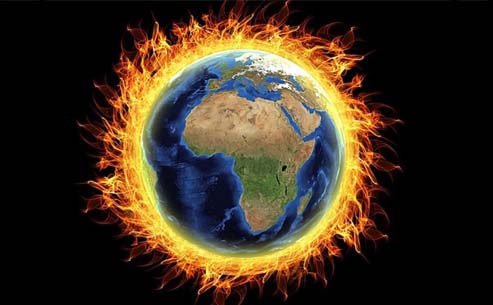
main content:
- 1 Greenhouse effect
- 2 Greenhouse gases
- 3 Climate warming is not a good thing
- 4Kyoto countermeasures and Bali route map
- 5 human choices
- 6 Preventive preparations in China
1.Greenhouse effect
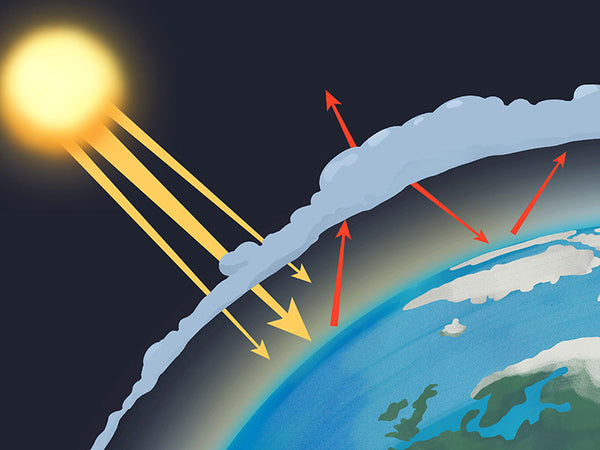
Greenhouse effect
Due to the long-term use of fossil energy by humans, in addition to causing haze, smog and acid rain in some areas, it will also cause global climate change, which is even more worrying.
People, especially those living in cities, generally feel climate warming. Since the record of meteorological instrument observations in 1860, the global average temperature has risen by about 0.6°C. The 13 warmest years all appeared after 1983. Since 1985, China has experienced 16 consecutive warm winters across the country. Scientists have been committed to studying the significant impact of human use of fossil energy and carbon dioxide (CO2) emissions on climate change, and they have repeatedly pointed out that since the Industrial Revolution, the CO2 in the atmosphere has gradually increased, leading to the "greenhouse effect" and global warming.
Why is the earth's climate warming? Some people associate it with the "heat island effect" in cities, and think that the warming is caused by humans' extensive use of energy to generate heat. In fact, the city consumes a lot of energy, and the temperature in the city is higher than that in the suburbs because of the high-rise buildings. It is like a heat island in the ocean. But the cause of global warming is not so simple. At present, all the energy used by humans in a year is equivalent to about 9 billion tons of oil. If all of this heat is used to heat seawater, the temperature of the seawater can only rise by 6×10-5°C. In other words, if the seawater is heated continuously for 10,000 years, the temperature of the seawater can only increase by less than 1°C. Obviously, the warming of the earth is not caused by the heat released by human beings using energy, but has "magic power". This "magic power" is the "greenhouse effect".
Picture: Earth's greenhouse effect
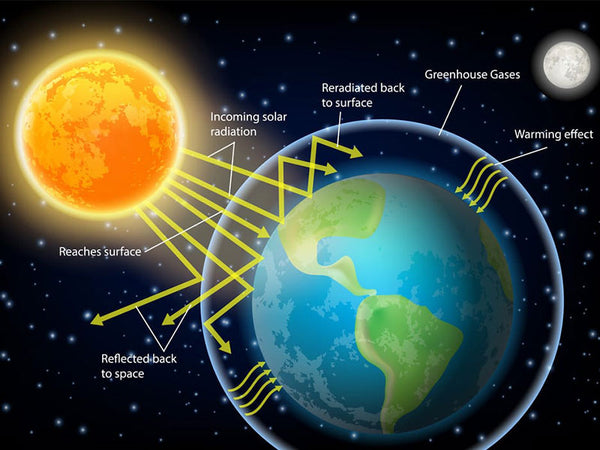
What is the "greenhouse effect"? In those cold places or cold seasons, when people close the doors and windows of their rooms, they will feel warmer. The indoor temperature is actually higher than that of the outdoors. This kind of room is a greenhouse. Outdoor plants such as flowers and vegetables are easily damaged by the cold. We often see gardeners and farmers build closed rooms with glass roofs on flower gardens and vegetable gardens, or cover them with transparent plastic films. This is also a greenhouse. The plants in the greenhouse will grow better, which is familiar to people. If people can make a similar cover to cover a city and turn the whole city into a greenhouse, or make the cover a little bigger and cover the earth too, so that the whole earth becomes a big greenhouse, is that good? Woolen cloth? That is not good, and it is beyond the reach of manpower. However, such a large greenhouse is possible. The atmosphere of the earth is like a big cover, which has already covered the whole earth in it, and no one can escape this cover. Fortunately, this atmospheric cover does not turn the earth into a greenhouse. While it transmits the light and heat radiation of the sun, it also allows the heat radiation on the ground to go out, and the flow in and out of it is balanced. If the composition of the atmosphere changes and too much special gas is added to prevent the ground heat from radiating to space, the ground and the atmosphere will increase in temperature due to the imbalance of heat entering and exiting the atmosphere. It has become an invisible greenhouse cover, turning the earth into a real big greenhouse, which is the "greenhouse effect". Climate warming is the emergence of this large greenhouse. People call the special gases that cause the greenhouse effect "greenhouse gases." CO2, the combustion product of fossil fuels, is one of the most important greenhouse gases, and its content in the atmosphere is too much.
Picture: Structure of the Earth's Atmosphere
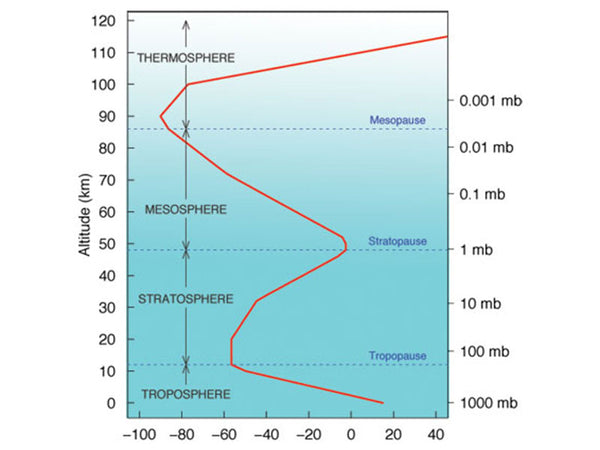
How do greenhouse gases warm the earth? Let us first understand the relevant structure of the atmosphere. The earth's atmosphere is about 300 kilometers thick, and it is divided into the troposphere, stratosphere, middle layer and thermoionosphere from bottom to top. The thickness of the troposphere varies from place to place. The polar regions and mid-latitudes are between 8 and 12 kilometers, and the equator is between 16 and 18 kilometers. They will vary with the seasons. The temperature of the troposphere decreases with height, and the vertical movement is strong. Weather activities are like wind, Rain, clouds, fog, and lightning mainly occur in this layer. From the top of the troposphere to 50 kilometers is the stratosphere, the lower part of the temperature distribution changes little with height, and the upper part, due to the high concentration of ozone (O3), absorbs ultraviolet radiation so that the temperature increases with height. This makes the stratosphere have a temperature inversion, so the vertical motion is weak, and there is only a large-scale advection motion. From the top of the stratosphere to 80 kilometers is the middle layer (also known as the dissipation layer) and the temperature decreases as the height increases. Above the middle layer is the thermal layer, and the temperature increases with height. In the atmosphere above 80 kilometers, due to solar radiation, nitrogen (N2) and oxygen (O2) molecules are ionized into positive ions and free electrons, so it is called the ionosphere. The quality of the atmosphere becomes increasingly thinner as the altitude increases. More than 80% of the total air quality is concentrated in the troposphere. The air quality above 30 kilometers only accounts for 1%, and the air quality above 50 kilometers (above the top of the stratosphere) is less than 0.1%.
The radiation of solar energy is high-temperature radiation, mainly short-wave radiation, including visible light and ultraviolet light. When the earth absorbs solar energy, it also radiates energy into space, achieving a balance of energy budget and maintaining the normal temperature of the earth. However, the normal temperature of the earth is about 15°C, and its radiation energy is low-temperature radiation, which is long-wave radiation. In the past when human interference was small, the long-wave radiation of the earth and the short-wave radiation energy absorbed by the sun were also balanced. Monoatomic gases in the atmosphere such as inert gases, diatomic gases such as oxygen (O2), nitrogen (N2), hydrogen (H2), etc., have negligible absorption of radiation and can be regarded as "transparent". Gases with more than three atoms such as carbon dioxide (CO2), water vapor (H2O), methane (CH4), sulfur dioxide (SO2), freons (CFCs), etc. are different. They have considerable absorption and radiation capabilities. The absorption and radiation of these gases are selective and can only absorb and radiate energy in certain wavelength ranges. For gases such as CO2, they can only absorb long waves, not short waves. In this way, CO2 can allow the sun’s short-wave radiation to pass freely, while absorbing the long-wave radiation from the ground. As a result, most of the sun’s Short waves can reach the ground through the atmosphere to heat up the earth, while long-wave radiation on the ground is strongly absorbed by gases such as CO2, which reduces the heat emitted to space, which is equivalent to being intercepted . The heat that the earth gets from the sun in a day is 1500×1016 kilojoules (kJ), which is equivalent to the total energy consumption of the entire mankind in 45 years. It only needs to intercept and accumulate a little bit. However, greenhouse gases such as CO2 absorb long-wave radiation, reheat the atmosphere, transfer heat to the ground, and warm the ground. This is the principle of the "greenhouse effect". The greater the content of greenhouse gases like CO2 in the atmosphere, the stronger the greenhouse effect, and the more obvious and intensified the earth's warming phenomenon.
Picture: Schematic diagram of greenhouse gases warming the earth
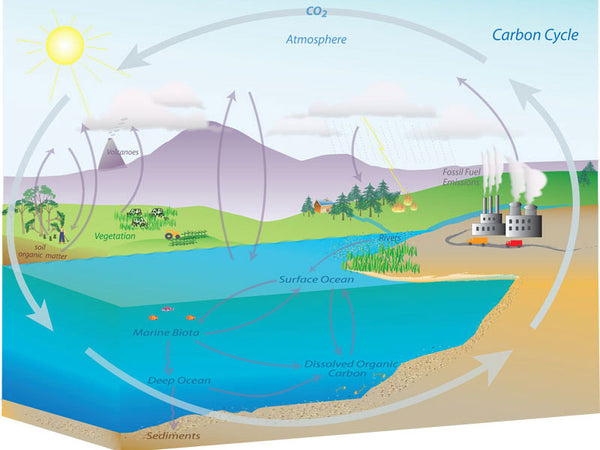
2.Greenhouse gases
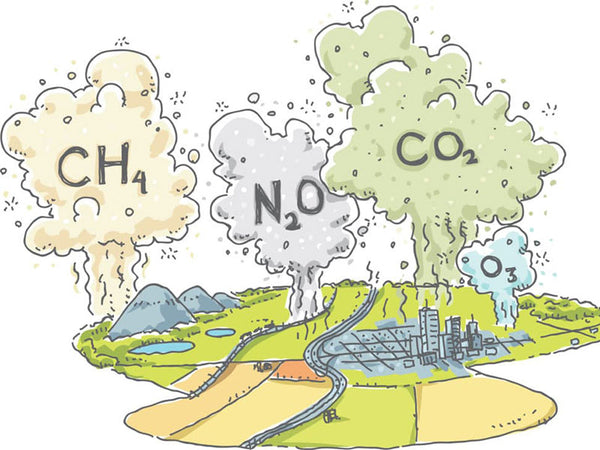
Greenhouse gases
Due to human activities, more than 30 kinds of gases that can cause the greenhouse effect have emerged, the most important of which are CO2, CH4, halogenated hydrocarbons (CFCs), nitrous oxide (N2O) and ozone (O3). The magnitude of their potential impact on climate change (called "radiative forcing") in the atmosphere, their "contribution" to the greenhouse effect (heating rate) and their life cycle are shown in the figure.
Picture: The main greenhouse gases in the atmosphere
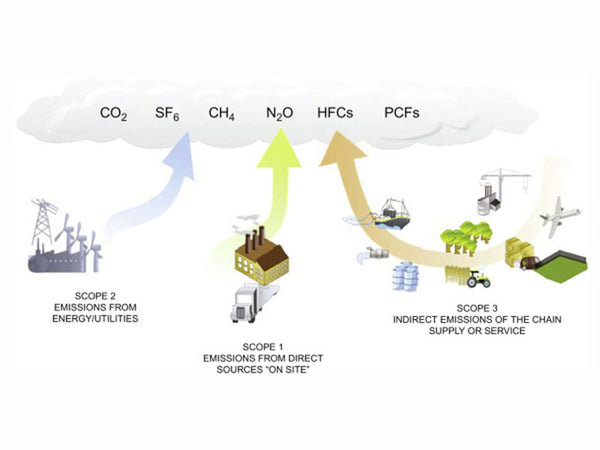
(1) Carbon dioxide is often regarded as a synonym for all greenhouse gases, but in fact its "contribution" to the greenhouse effect is currently only about 64%. Of course, this percentage is enough to show that it is the main greenhouse gas. Before the industrial revolution, when fossil energy was not used on a large scale, the mass fraction of CO2 in the atmosphere was about 2.8×10-4. By 1995, it had reached 3.62×10-4, an increase of 29% compared to before the industrial revolution. With the increase in consumption, the increase in the CO2 mass fraction is also accelerating, with an annual increase of about 0.46%. The sources of increase are roughly coal (accounting for 31.0%), fuel oil (accounting for 31.4%), natural gas (accounting for 12.9%), deforestation (accounting for 3.5%), land use change factors (accounting for 19.1%), etc.
(2) Methane is the second major greenhouse gas. The radiative forcing of a methane molecule is 56 times that of a carbon dioxide molecule. Before the industrial revolution, the mass fraction of methane in the atmosphere was about 0.8×10-6, and now it has more than doubled to about 17×10-6. It is still increasing at a rate of 0.7% every year, faster than the increase in carbon dioxide content. The sources of CH4 in the atmosphere are coal-bed methane escaped from coal mining accounted for 7%, natural gas drilling and transportation leakage accounted for 9%, burning biomass accounted for 8%, rice cultivation accounted for 22%, marsh and wetland peat decomposition accounted for 21%, ruminant Animal intestinal miasma discharge accounts for 15%, in addition to the discharge of natural gas hydrate in landfills and permafrost. Although the radiative forcing of methane molecules is many times larger than that of carbon dioxide, because the content of methane in the atmosphere is 2 to 3 orders of magnitude lower than that of CO2, its contribution to the greenhouse effect is much lower than that of carbon dioxide, only 19%. It can be seen from the source of methane in the atmosphere that it is currently mainly from the natural biological world. However, there are two sources that must cause people to be highly vigilant: one is that with the growth of natural gas consumption and consumption, the leakage of methane will increase significantly; the other is that with the warming of the climate, the natural gas in the permafrost in the cold zone will be hydrated. The waste will release a large amount of methane. Once the content of methane in the atmosphere increases substantially, its contribution to the greenhouse effect will also increase substantially, which is troublesome enough. Although the following three types are not directly related to fossil energy, they are also greenhouse gases.
(3) Halogenated hydrocarbons, including fluorine, chlorine, bromine, and iodine hydrocarbon gases, most of which are chlorofluorocarbons (commonly known as "freons"), which are synthetic substances. These substances are stable in nature and not easy to burn, and are widely used as refrigerants, fire extinguishing agents, cleaning agents, sprays, etc. They are well known for causing the destruction of ozone in the Antarctic stratosphere. They are also the main greenhouse gases, ranking third, and their current "contribution" to the greenhouse effect is still about 10%. There are also varieties of these compounds that do not destroy ozone. Promoted by the Montreal Convention in 1987, they are rapidly replacing the varieties that destroy ozone. However, there is a category of perfluorocarbons (PFCs) such as CF4 and C2F6 in these alternatives. Greenhouse gases with a long life cycle and strong radiative forcing are growing rapidly, which is worthy of vigilance.
(4) Nitrous oxide (N2O), whose molecular contrast radiative forcing is 280 times that of carbon dioxide, comes from the production of nitrogenous fertilizers and the burning of fossil fuels and biofuels, and currently accounts for about 6% of the "contribution" to the greenhouse effect.
(5) Ozone (O3) is also a major greenhouse gas, which is usually produced by biomass combustion and petrochemical by-products. Ozone has special properties. It can not only block short-wave radiation that enters the ground and benefit humans and organisms, but it can also absorb long-wave radiation from the ground. The nature of ozone is very lively, its life cycle is only a few weeks, and its content in the atmosphere varies with latitude, altitude and season. In the lower troposphere, ozone can promote the production of photochemical smog in cities and industrial areas. Although its content in the troposphere has an increasing trend, increasing by 1% to 2% every year, its content in the entire atmosphere is declining. Since long-term measurements of ozone in the lower troposphere are rarely carried out at present, its "contribution" to the greenhouse effect has not yet been determined.
3.Climate warming is not a good thing
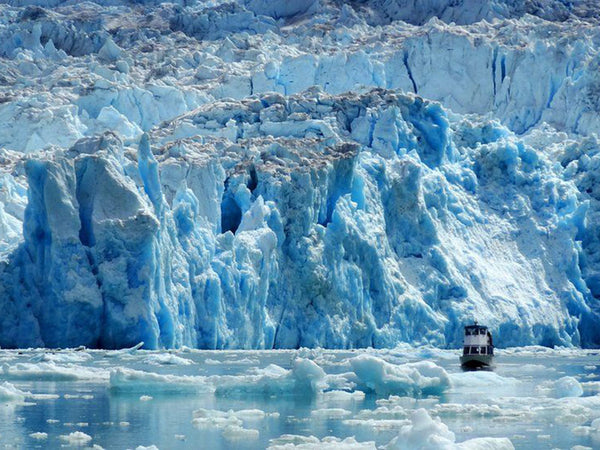
Climate warming is not a good thing
Is there any harm in the warming of the earth and climate warming caused by the greenhouse effect? This is also something people care about.
Climate warming has a significant impact on the global ecological environment. The first is the melting of glaciers in the Antarctic and Arctic regions, which has caused the sea level to rise and threaten the living environment of human beings. The huge ice sheets and glaciers on Antarctica are connected to floating ice shelves, and the ice shelves become the pillars of the glaciers. Warming ocean currents and atmosphere can make ice shelves fragile and crack and loosen. Blocked glaciers begin to flow into the ocean, and the melting of glaciers causes sea levels to rise. In the Arctic region, the climate is warming faster than other regions. The total ice coverage is declining. The sea ice in the Arctic Ocean has shrunk by 9% in the past 10 years. The water surface absorbs more solar energy, which also causes further climate warming. There are also landmass such as Greenland’s ice caps and glaciers that have rapidly melted in recent years, which has also caused sea levels to rise. Records indicate that the sea level has risen by nearly 20 centimeters in the 20th century. Some people predict that the global sea level may rise by 1 meter at the end of the 21st century, which is very sensitive to countries and regions with very low elevations. For example, the Maldives in the Indian Ocean will face extinction; Bangladesh has 17 million people living in areas less than 1 meter above sea level, and they are panicking because of rising sea levels; large areas of land in many coastal countries will be inundated and the lives of hundreds of millions of people will be affected. threat. It is conceivable that if there are disasters like the Indian Ocean tsunami in December 2004 and Hurricane Katrina in New Orleans, the United States in August 2005, the losses will be even more severe.
Picture: global warming sea level rise

The current accelerated melting of the Arctic ice sheet is an ominous sign of climate warming, but some ridiculous things are happening there in recent years. Some countries near the Arctic have intensified their competition for sub-ice resources. There are abundant oil, natural gas, diamond, and metal resources under the ice, which may be easier to extract due to the melting of the ice cap. Some people are also planning to open up new routes. Some countries can reduce the voyage from Western Europe to Southeast Asia by tens of thousands of kilometers through the Arctic Ocean route.
If so, man-made development activities will exacerbate the destruction of ice sheets and the extinction of species. It seems that a treaty to protect the Arctic needs to be concluded. Like the Antarctic Treaty that entered into force in 1961, the fight for Arctic sovereignty is frozen, and the climate is warming, glaciers in the mountains are shrinking, and floods and droughts are aggravating. The Himalayas glaciers have become the fastest retreating glaciers in the world, retreating 10 to 15 meters a year, and the current retreat speed is still accelerating. The glaciers on the Qinghai-Tibet Plateau are retreating and intensified in the 1990s. In the past 30 years, the glacier area of the entire plateau area has shrunk by more than 4,400 square kilometers, which is 9% less than in the 1970s, and an average annual reduction of 147 square kilometers. This has had a significant impact on the ecological environment of the surrounding areas, floods and floods. Droughts have been intensified alternately, which also constitutes climate warming for places that rely on glaciers and snow for water resources, causing agriculture to face major fluctuations. The layout and structure of agriculture and production conditions around the world will undergo major changes, and agricultural output will also fluctuate greatly. Rising temperatures have accelerated the development of crops and shortened their growth periods, resulting in a decline in yield and quality. In China, the output of the three major food crops, wheat, rice and corn, is declining.
Climate warming has caused changes in the ecological environment and reduced biodiversity. As the ice shelf is melting, the Antarctic krill has lost their habitats, causing a "famine" of animals and animals in the food chain. Krill relies on the seaweed under the sea ice to survive and reproduce. Due to the decrease in sea ice in the past 50 years, the number of krills has declined sharply. Many species such as whales, seals and penguins, which use krill as their main food source, are facing survival crisis. In the Arctic, as the ice sheet has shrunk by 15% to 20% in the past 30 years, polar bears and millions of polar lives are threatened to varying degrees. In North America, due to climate change, some animals such as butterflies and foxes migrated to their habitats, some birds hatched early, plants bloom earlier, and some organisms that do not adapt to changes in the climate are becoming extinct. According to research, if the global average temperature rises by more than 1℃, the ecological damage will increase sharply, the rate of species extinction will increase rapidly, and the frequency of extreme weather will increase. The heat wave that has swept the northern hemisphere in recent years is worrying. Many countries have experienced intense heat, and the temperature in Europe has set an unprecedented record; some parts of India have temperatures as high as 45~49℃; Canada, the United States, China, and parts of Russia all set record high temperatures in 2003. Moreover, the frequency of extreme weather of this kind of sweltering heat is getting higher and higher. Obviously, it cannot be explained by natural causes such as sunspots and volcanic activity. The pollution caused by human activities must be the main reason. Climate warming has also triggered some extreme weather events such as typhoons, floods, hail, and cold currents, or has made these natural disasters more violent, and the world has suffered greatly. The devastating power of Hurricane Katrina in the United States in 2005 is not unrelated to global warming. If the power of this hurricane is a little weaker, New Orleans may be able to avoid the collapse of the bank and turn into a country of Zee, which can avoid losses of about 200 billion US dollars.
Climate warming affects human health. With the global warming, diseases transmitted by insects such as malaria and dengue fever may affect 40% to 50% of the world's population. The increase in pests and diseases and the propagation of bacteria increase the incidence of cholera, malaria and yellow fever, which is extremely harmful to the population in densely populated areas. The increase in the number of high temperature days in summer has increased the incidence and mortality of heart disease, high blood pressure and high temperature-related diseases.
4.Kyoto countermeasures and Bali route map
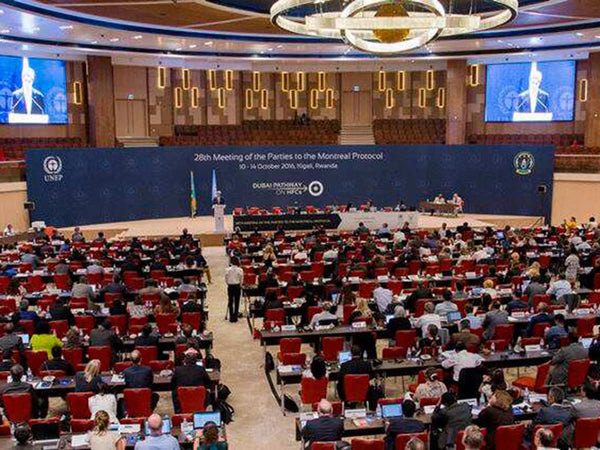
Kyoto countermeasures and Bali route map
Taking into account the need for authoritative decision-making, in November 1988, the World Meteorological Organization (WMO) and the United Nations Environment Program established the Intergovernmental Panel on Climate Change (IPCC). The committee issued its first report in 1990, clarifying that climate change is indeed a huge threat to mankind, calling for the conclusion of a global convention negotiation working group, and in May of that year completed the United Nations Framework Convention on Climate Change (UNFCCC). , Hereinafter referred to as the "Convention") text. In June 1992, the United Nations Conference on Environment and Development (Earth Summit) was held in Rio de Janeiro, Brazil. The "Convention" was adopted by the General Assembly. 153 countries and regional integration organizations formally signed the "Convention". On March 21, 1994, The Convention officially entered into force. As of December 2001, a total of 187 countries and regional integration organizations have become contracting parties. The "Convention" aims to control the emission of six kinds of gases, including CO2, which cause the greenhouse effect in the atmosphere. The ultimate goal is to "stabilize the concentration of greenhouse gases at a level that prevents the climate system from being dangerously disturbed by humans." The Convention stipulates differentiated obligations and procedures for fulfilling obligations between developed and developing countries. It requires developed countries, as major greenhouse gas emitters, to take specific measures to limit greenhouse gas emissions and provide developing countries with funds to support them. They fulfill their obligations under the Convention, while developing countries only undertake the obligation to provide lists of greenhouse gas “sources” and “sinks” (emissions and governance), formulate and implement relevant measures and plans, and do not assume the obligation to limit greenhouse gases.
The Parties to the Convention held their first meeting in Kyoto, Japan in December 1997. 149 countries and regions, including 34 major industrial countries, participated in the meeting. A legally binding document.
| Tips: 6 types of wet room gases that need to be controlled
There are 6 types of "greenhouse gases" that need to be controlled under the "United Nations Framework Convention on Climate Change":Carbon dioxide (CO2); Methane (CH4) Nitrous oxide (N2O); Hydrofluorocarbons (HFCs); Perfluorocarbons (PFCs); Sulfur hexafluoride (SF6). |
The full name of the "Kyoto Protocol" is "the Kyoto Protocol of the United Nations Framework Convention on Climate Change" (hereinafter referred to as the "Protocol"), which is actually an additional text of the "Convention". The core principle of the Protocol is common but differentiated. The common thing is that each country has to shoulder its own responsibilities. The difference is, first of all, the difference between developed and developing countries. The "Protocol" recognizes that developed countries have completed industrialization and have assumed more historical responsibilities in response to global warming, and this situation has not changed. The developed countries, which account for 22% of the world’s population, consume more than 70% of the world’s energy and emit More than 50% of greenhouse gases. Therefore, the "Protocol" only sets emission reduction tasks for industrialized countries, and does not make this requirement for developing countries. Secondly, the developed countries should also be treated differently. The "Protocol" stipulates that, before 2012, the greenhouse gas emissions of major industrialized countries shall be reduced by an average of 5.2% on the basis of 1990.
| Tips: "Kyoto Protocol" emission reduction allocation regulations The "Kyoto Protocol" stipulates that before 2012, the greenhouse gas emissions of major industrialized countries will be reduced by an average of 5.2% on the basis of 1990. Specifically, the EU will cut 8%, the United States will cut 7%, and Japan will cut 6%. Canada will cut it by 6%, and Eastern European countries will cut it by 5% to 8%. New Zealand, Russia and Ukraine do not need to cut, and stabilize at 1990 levels. Allow Ireland, Australia and Norway to increase emissions by 10%, 8% and 1% respectively over 1990. |
The Protocol adopts three very flexible transnational emission reduction mechanisms, namely the Joint Implementation Mechanism (J), the “Clean Development Mechanism” (CDM) and the “Emissions Trading Mechanism” (ET) to encourage countries to actively implement their emission reduction obligations The "joint implementation mechanism" means that two or more countries with emission reduction tasks can work together to achieve the total emission reduction targets of the two countries. The "clean development mechanism" allows a country with emission reduction tasks to work together. , By helping developing countries to achieve their own emission reduction tasks. For example, the United Kingdom helps China and calculates the emissions reduced by China in the projects being helped to the United Kingdom, so that the United Kingdom can reduce more emissions with less funds, and China has also benefited from technological progress. "Emissions trading mechanism" refers to allowing a country to purchase emissions from another country, which allows developed countries to sell some of the saved emission credits to other countries.
The "Protocol" stipulates that the "Protocol" must meet two conditions for its entry into force: one is that more than 55 countries have approved the "Protocol" through the procedures of China; the other is that the total CO2 emissions of countries that have ratified the "Protocol" in 1990 accounted for at least 1990. In that year, the world's total CO2 emissions were more than 55%. However, because the United States, which accounted for 14 of the total global CO2 emissions ( CO2 emissions accounted for 36.1% of the world's total emissions in 1990), announced its withdrawal from the "Protocol" in March 2001, and the entry into force of the "Protocol" was in crisis. The Clinton administration signed the "Protocol" in 1998, but the Bush administration announced its withdrawal under the pretext of "affecting the development of the US economy" and "developing countries should also undertake emission reduction obligations." When persuasion is ineffective, the international community has turned its attention to Russia one after another. Russia's CO2 emissions in 1990 accounted for 174% of the world's total CO2 emissions, which is very important. If Russia ratifies the "Protocol", the "Protocol" can meet the requirements for entry into force. Russia is hesitant, and China has a fierce dispute, only for fear that the "Protocol" will hinder economic development. After 3 years of wandering and gaming, the Russian Duma (lower house of parliament) and the Federal Council (upper house of parliament) finally ratified the "Protocol" in October 2004, and President Putin signed it on November 5 to the UN Secretary on November 18. Chang Annan submitted the formal approval document, which means that the "Protocol" can officially enter into force on February 16, 2005.
The content of the "Protocol" has one common, two differences, and three mechanisms very cleverly formulated, which can be called a brilliant strategy. It makes a legal document that obviously means restricting the use of fossil energy and that may affect economic development has been approved by most countries. The principle of "common" is the responsibility of every country, and it is incumbent on everyone who is a "global village". "Two differences". Developed countries should first assume the obligation to reduce emissions, which reflects their historical responsibility, and there is no room for excuse; the task of reduction is not heavy, but it is not difficult to achieve it; there are three flexible mechanisms that are also profitable, so they support The "Protocol". Developing countries do not need to undertake emission reduction obligations for the time being, and may receive economic and technical assistance from developed countries, which is also good for their own progress and development, so they also agree to the "Protocol."
The "Protocol" comes into effect, and developed countries must reduce CO2 and other greenhouse gases by 52% on average. This number seems trivial, and it is still difficult to implement, but after all, it is the first step taken by mankind in the fight against climate change, and it is of milestone significance. Moreover, this kind of global environmental management efforts will not stagnate after 2012 (ie, the "post-Kyoto Protocol era") climate issues will be discussed in 2005. The mechanism conceived in the "Protocol" has the vitality of long-term development and will provide a blueprint that can be used for reference in the future efforts of mankind.
From December 3rd to 15th, 2007, the United Nations held another climate change conference. More than 180 parties to the "Convention" held the 13th meeting in Bali, Indonesia, to discuss how to deal with climate change in the "post-Kyoto Protocol era". The "Bali Road Map" stipulates that a meeting will be held before 2009 on new arrangements for addressing climate change issues, which will be a step forward on the basis of the "Kyoto Protocol." The United States expressed its support for the "Road Map" at the last moment of this meeting and was praised.
5.Human choice

Human choice
Not all countries attach importance to the greenhouse effect and global warming, and they adopt different attitudes. Some countries take an irresponsible attitude. For example, the United States believes that the "Protocol" will reduce greenhouse gas emissions will affect the country's economic development, and announced its withdrawal from the "Protocol." Because American entrepreneurs who support the Bush administration do not want the "Protocol", many Americans are unwilling to change their lifestyle of excessive consumption of resources.
|
Tips: Bali Road Map
|
Some countries have a "don't care" attitude, such as Russia. Although Russia finally ratified the "Protocol" is fortunate and praiseworthy, but it also reflects that they have their own ideas. In February 2005, President Putin’s economic adviser Andrei Ilarionov publicly stated at the Esset Climate Conference: Russia does not hate global warming, and global warming will make the cold Siberian desolate zone. Become more alive. The Russians are not afraid of climate change but they are afraid that ratification of the "Protocol" will affect economic development, so they show hesitation.
There are also blind skeptics. Although the greenhouse effect has become an indisputable fact and recognized by the scientific community, it is the consensus of the world that there are still a few scientists and politicians who have rebellious psychology and believe that extreme phenomena have not yet appeared, so there is no need to worry about them. They asked: Has there been a climate disaster in the Arctic? Has the Antarctic ice sheet melted? Will the sea flood the land? Will mankind be destroyed? and many more. The answer to these questions is obviously "no, not yet", so they concluded that "global warming" is a media hype, a myth, that does not actually exist. These people also acknowledge the facts of greenhouse gases and the greenhouse effect, but they can't put forward any necessary preventive measures, and they seem to be left alone. On the contrary, the slowness of environmental changes and the "lag effect" characteristics can easily blind many people and provide great convenience for skeptics.
Many scientists believe that when the global average temperature is 2°C higher than before the industrial revolution (that is, before 1750), there will be a critical point for disaster. The temperature has now risen to 0.8°C, which is only 1.2°C. It is predicted that when the mass fraction of CO2 in the atmosphere reaches 4×10-4, it will inevitably lead to a global temperature increase of 2°C. The current CO2 mass score is 3.79×10-4, and with an annual mass score of 2×10-6 growth, it will exceed the 4×10-4 threshold within 10 years. The IPCC assessment report in 2001 pointed out that the global average temperature will rise by 1.8~4℃ by 2100.
On February 2-4, 2005, British Prime Minister Blair invited more than 200 scientists from more than 30 countries to participate in the Exeter Climate Conference, which is currently the largest climate summit of this century. Participants regarded the global average temperature increase of 2°C as an acceptable safety bottom line. Scientists believe that breaking through this bottom line means ecological disaster, and the global ecology will suffer a terrible blow. However, scientists believe that the goal of controlling the safety bottom line will be difficult to achieve by 2050. Even if the global CO2 emissions are reduced to less than half of 1990, the mass fraction of CO2 in the atmosphere will still reach more than 55×10-4, because CO2 has a life span of more than a hundred years and cannot be easily reduced. Having said that, we should revisit the warnings of the American biologist and famous environmental protection pioneer Rachel Carson. She pointed out in the 1962 book "Silent Spring": "We have long been This road that has been driving makes it easy to mistakenly think that it is a comfortable and flat super highway. We ran on it at high speed. In fact, there is disaster waiting at the end of this road. Another fork of this road -A fork in the road that few people take, providing us with the last and only chance for us to keep our planet." Her horrifying shout awakened the world. Nowadays, facing the issue of global warming, mankind has to make a choice between the risk of paying a higher price in the future and giving up part of the immediate benefits for long-term benefits. Either start looking for a solution now, or wait until you have personally experienced the damage caused by climate change and can no longer stand it.
6.China's preventive preparations
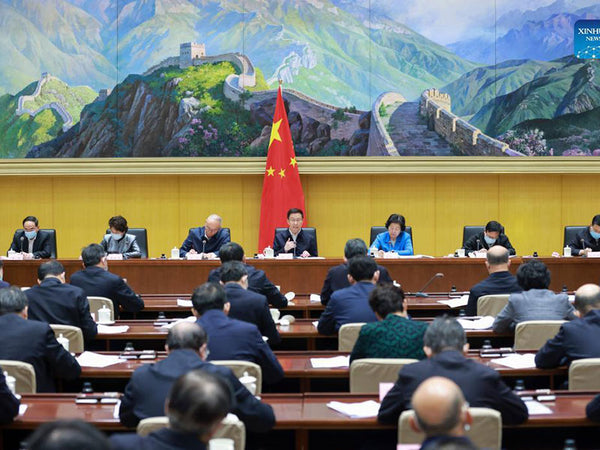
China's preventive preparations
China attaches great importance to the "Kyoto Protocol" and ratified the "Protocol" in September 2002. China is a developing country and is a country that does not need to cut greenhouse gas emissions. People have the best understanding of China’s opposition to making emission reduction commitments. At present, many areas in China are still in poverty. China must put economic development and improving people's living standards in the first place. However, it must be admitted that China is also a major country in the process of industrialization and modernization, and it is an important player on the international stage, both in terms of economy and in terms of ecological environment. China is the most populous country in the world and the largest coal consumer. At present, China's greenhouse gas emissions rank first in the world, and it is expected to be on par with the United States by 2020. The prevailing international opinion believes that to achieve the ultimate goal of the Convention on “stabilizing the concentration of greenhouse gases in the atmosphere at a level that prevents the climate system from dangerous man-made interference”, it is a prerequisite for China to implement massive emission reductions. This puts China facing tremendous international pressure.
China is currently in the mid-stage of industrialization, and the characteristics of the heavy chemical industry are very obvious. Industry’s share of GDP has grown rapidly, reaching 63% in 2003. Industries such as electric power, steel, machinery and equipment, automobiles, shipbuilding, chemicals, electronics, and building materials have become the main driving forces for the growth of the national economy. This new feature of heavy chemical industry means that China's industry will inevitably consume a large amount of energy and resources for a period of time, and emit CO2. Energy supply and energy security have become the main constraints restricting China's industrialization. Faced with the dual pressures of energy and environment, China still needs to put the realization of industrialization and modernization and the right to development in the first place in participating in international activities in the field of climate change and in the negotiation of the implementation of the Convention, so as to strive for the necessary emissions space for future development. At the same time, we must take precautions, turn pressure into motivation, and seek a "low-carbon" development path. Once rapid development is achieved, China will be able to make positive contributions to the mitigation of climate change.
The so-called "low carbon" refers to reducing fossil energy consumption and energy consumption, and reducing CO2 emissions. The low-carbon development path should include three aspects: The first is to control high-energy-consuming industries and avoid excessive development of high-carbon-density production projects. Of course, the heavy chemical and high-energy-consuming industries that China needs are still to be developed, but the high-energy-consuming industries for exports must be controlled, and the transfer of foreign high-carbon projects to China must be vigilant. For example, the electrolytic aluminum, calcium carbide, and ferroalloy industries are "electric tigers". China's online output has exceeded China's demand by more than twice. However, because these products are popular in the international market, many places are still scrambling to build production lines and compete to export products. This kind of industry that provides high energy consumption and high emission products for other countries must be controlled as soon as possible. It is wise for the state to issue measures to abolish the export tax rebate for products such as electrolytic aluminum and impose export taxes in 2004. Regarding the transfer of foreign high-carbon projects, we cannot choose food without hunger and think that "everything is in the basket". Once the country is bound by the "Convention" to reduce CO2 emissions, these high-carbon projects will be in an awkward state. If the factory is closed again at that time, it will cause even greater losses, such as unemployment of workers, and it is difficult to recover the huge investment in fixed assets.
The second is to save energy and improve energy efficiency. China's use of energy is still relatively extensive, and the energy consumed to produce the same product is 20% to 30% more than the advanced level of foreign countries. It should be said that it is not difficult to reduce energy consumption by a few percentage points and emissions by a few percentage points from production and life by saving and improving energy efficiency.
The third is the development of low-carbon and non-carbon new energy, mainly renewable energy, we will focus on it later.
Actively planting trees and afforestation to increase forest coverage is also an effective way to reduce net CO2 emissions. In this regard, China has made great achievements and accumulated experience. The absorption and use of CO2 by forests and vegetation is an important part of the natural "carbon cycle". Since the late 1970s, China has been planting a large number of trees and afforestation. The original intention was to prevent soil erosion and drought, and objectively it also had an unexpected effect of absorbing CO2 . In the 25 years from 1980 to 2005, afforestation projects have increased China's forest coverage to 18%, and the accumulated absorption of CO2 is about 3 billion tons, accounting for 5%-10% of China's anthropogenic emissions. On September 8, 2007, at the Asia-Pacific Economic Cooperation (APEC) Leaders’ Meeting, President Hu Jintao proposed China’s plan to reduce greenhouse gas emissions, which is to expand forest coverage and increase CO2 absorption sources to seek international cooperation. This is China’s initiative to respond to the global The climate change plan, known as the "forest plan", shows China's positive attitude on environmental issues.